 Coastal Submersibles (U-class long hull)
Coastal Submersibles (U-class long hull)
V-class: 22 +24 cancelled, War Emergency Programme 1942, built 1942-1944
WW2 British Submersibles:
X1 | Odin | Parthian | Rainbow | Thames | Swordfish | Porpoise/Grampus | Shark | U class | T class | S class | U class 1940 SH | P611 class | V class (U 1941/42 LH) | X-Craft | A classThe V-class, officially the “U class, long hull”, was a late war ultimate variant of the wartime U-class, the third pillar of the British underwater Forces in world war two, especially active in the Mediterranean. These were a development of the 1937 Undine and 1940 “short hull” class, boosted by wartime experience. This class, laid down in 1942-43 and completed in 1943-45, had its stern lengthened to give an easier angle of approach of water to the propellers in order to reduce noise, with a further fining of the bows. The hull had welded framing and the riveted plating was increased from half to three-quarter of an inch, so that the operational depth limit was increased to 300ft. None was sunk in action, Some were transferred in wartime, but most were sold postwar as surplus, to Norway, Greece, France and Denmark.

Development
The U-class “long hulls”
The U class, with 49 completed, was among the unsung heroes of the British underwater service. They were the smallest of the trio mass-built in WW2, but started in the interwar, the T (large oceanic), S (medium ocanic) and the U (coastal) types. The U-class originated in fact with a March 1934 specification for a “Small, Simple, Submarine, for Anti-Submarine Training, etc.”. Almost an auxiliary type leading to the construction of the three Unity class ordered in November 1936. They became the smallest British subs since WWI. Their trademarks were a 500 tonnes standard displacement (in reality 540 long tons), a riveted steel hull 0.5 inches (13 mm) thick to dive to 200 ft (60 m), which was basically equivalent to their own length, at two meters or 10 feet difference. In case of war, they were intended either to hunt German shipping in the Baltic, or Italian lines of communication in the Mediterranean, albeit this was the job of the Marine Nationale.
Fast forward, and in September 1939 a war emergency program planned the construction of at least two main types of submarines, the large T class and smaller S-class. Then after the French defeat in June 1940, the need for submersibles in the Mediterranean urged the construction en masse of a more affordable, smaller type, a requirement for which the U-class seemed fitting like a glove. This led to the mass order of 45 “short hulls” as part of the 1940 and 1941 programmes, a simple repeat of the Undine design.
Naming
According to the recommendation of the Hopwood Committee of 1926, the boats had names beginning with the same letter in the alphabet, but the vocabulary was not that extensive for “U”, thus Churchill (which played around with names when approving construction as PM) simply suggested swapping to “V” names, while keeping the overall “U class” administrative classification, easier for the Navy to manage. Thus, the last units of the wartime U-class were HMS Vandal (initially P58), Vitality, Varangian, Varne and Vox. Most were resurrected from cancelled “V-W” destroyers of 1918. They were named after leftovers of the other wartime “V” class, destroyers related to the 1942 S-T-U-V-W superclass. Part of the 42 subs ordered still had “U” names as well: Upshot, Urtica were actually completed, but Ulex, Upas, Utopia, Unbridled, Upward, were cancelled. The four Norwegian boats received new “U” names as well. For convenience, since V class names were more numerous, we will stick to the “V class” here.
Specifics
Thus, the later U class, officially “1941 long hull” and “1942 programme”. In all, 42 were ordered, but 34 named, 8 never named, and 22 completed. They were still “500-tonners”, but reached 545 long tonnes standard instead of 540, and had many differences, chiefly as said above, an incremental improvement for depth and speed. The stern was lengthened to give an easier angle of approach of water to the propellers in order to reduce noise, with a further fining of the bows. The hull had welded framing and the riveted plating was increased from half to three-quarter of an inch, so that the operational depth limit was increased to 300ft.
Construction
Cancellations:
Barrow: Ulex, Upas, Utopia, Veto, Virile, Visitant
Vickers-Armstrong, Tyne: Unbridled, Upward, Vantage, Vehement, Venom, Verve +8 unnamed units.
Norwegian service: Venturer, Viking, Vartance and Votary (renamed Utstein, Utvaer, Utsira and Uthaug).
Greek service: Veldt in 1944—57 as Pipinios, Vengeful 1945 57 as Delfin, Virulent 1946-58 as Argonaftts, Volatile 1946-58 as Traina
French Services: Vineyard and Vortex went to France in 1944 as Doris and Morse until 1947
Danish Service: Voracious (Saelen), Vulpine (Storen), in service until 1958.

⚙ V-class specifications |
|
| Displacement | 545 tons standard, 658 tons FL, 740 tons submerged |
| Dimensions | 204 ft 6 in x 16 ft 1 in x 15 ft 3 in (62.33 x 4.90 x 4.65 m) |
| Propulsion | 2 shaft Paxman diesels, 2 Vickers electric motors, 615 hp (459 kW)/825 hp (615 kW) |
| Speed | 11.25 kn surfaced, 10 knots submerged |
| Range | See notes |
| Armament | 4x 21-in (533 mm) TTs (8), 1x 3-in(76mm) deck gun. |
| Max depth | 200 ft (61 m) |
| Sensors | Type ? Hydrophones |
| Crew | 33 |
Career of the V-class
1941 “long hull” program
 HMS Vampire
HMS Vampire
To be completed in 2026
 HMS Veldt
HMS Veldt
To be completed in 2026
 HMS Venturer
HMS Venturer
To be completed in 2026
 HMS Vigorous
HMS Vigorous
To be completed in 2026
 HMS Viking
HMS Viking
To be completed in 2026
 HMS Virtue
HMS Virtue
To be completed in 2026
 HMS Visigoth
HMS Visigoth
To be completed in 2026
 HMS Vox
HMS Vox
To be completed in 2026
 HMS Upshot
HMS Upshot
To be completed in 2026
 HMS Urtica
HMS Urtica
To be completed in 2026
 HMS Vagabond
HMS Vagabond
To be completed in 2026
 HMS Variance
HMS Variance
To be completed in 2026
 HMS Varne
HMS Varne
To be completed in 2026
 HMS Vengeful
HMS Vengeful
To be completed in 2026
 HMS Vineyard
HMS Vineyard
To be completed in 2026
 HMS Virulent
HMS Virulent
To be completed in 2026
1942 programme
 HMS Vivid
HMS Vivid
To be completed in 2026
 HMS Volatile
HMS Volatile
To be completed in 2026
 HMS Voracious
HMS Voracious
To be completed in 2026
 HMS Vortex
HMS Vortex
To be completed in 2026
 HMS Votary
HMS Votary
To be completed in 2026
 HMS Vulpine
HMS Vulpine
To be completed in 2026
Read More/Src
Books
Walters, Derek (2004). The History of the British ‘U’ Class Submarine. Leo Cooper.
Conway’s All the World’s Fighting Ships 1922–46
Links
https://uboat.net/allies/warships/class.html?ID=51&navy=HMS
https://en.wikipedia.org/wiki/British_V-class_submarine
https://www.battleships-cruisers.co.uk/v_class.htm
Videos
to come
Model Kits
none found
3D
none found


 Latest Facebook Entry -
Latest Facebook Entry -  X(Tweeter) Naval Encyclopedia's deck archive
X(Tweeter) Naval Encyclopedia's deck archive Instagram (@navalencyc)
Instagram (@navalencyc)





 French Navy
French Navy Royal Navy
Royal Navy Russian Navy
Russian Navy Armada Espanola
Armada Espanola Austrian Navy
Austrian Navy K.u.K. Kriegsmarine
K.u.K. Kriegsmarine Dansk Marine
Dansk Marine Nautiko Hellenon
Nautiko Hellenon Koninklije Marine 1870
Koninklije Marine 1870 Marinha do Brasil
Marinha do Brasil Osmanlı Donanması
Osmanlı Donanması Marina Do Peru
Marina Do Peru Marinha do Portugal
Marinha do Portugal Regia Marina 1870
Regia Marina 1870 Nihhon Kaigun 1870
Nihhon Kaigun 1870 Preußische Marine 1870
Preußische Marine 1870 Russkiy Flot 1870
Russkiy Flot 1870 Svenska marinen
Svenska marinen Søværnet
Søværnet Union Navy
Union Navy Confederate Navy
Confederate Navy Armada de Argentina
Armada de Argentina Imperial Chinese Navy
Imperial Chinese Navy Marinha do Portugal
Marinha do Portugal Mexico
Mexico Kaiserliche Marine
Kaiserliche Marine 1898 US Navy
1898 US Navy Sovietskiy Flot
Sovietskiy Flot Royal Canadian Navy
Royal Canadian Navy Royal Australian Navy
Royal Australian Navy RNZN Fleet
RNZN Fleet Chinese Navy 1937
Chinese Navy 1937 Kriegsmarine
Kriegsmarine Chilean Navy
Chilean Navy Danish Navy
Danish Navy Finnish Navy
Finnish Navy Hellenic Navy
Hellenic Navy Polish Navy
Polish Navy Romanian Navy
Romanian Navy Turkish Navy
Turkish Navy Royal Yugoslav Navy
Royal Yugoslav Navy Royal Thai Navy
Royal Thai Navy Minor Navies
Minor Navies Albania
Albania Austria
Austria Belgium
Belgium Columbia
Columbia Costa Rica
Costa Rica Cuba
Cuba Czechoslovakia
Czechoslovakia Dominican Republic
Dominican Republic Haiti
Haiti Hungary
Hungary Honduras
Honduras Estonia
Estonia Iceland
Iceland Eire
Eire Equador
Equador Iran
Iran Iraq
Iraq Latvia
Latvia Liberia
Liberia Lithuania
Lithuania Mandchukuo
Mandchukuo Morocco
Morocco Nicaragua
Nicaragua Persia
Persia San Salvador
San Salvador Sarawak
Sarawak Uruguay
Uruguay Venezuela
Venezuela Zanzibar
Zanzibar Warsaw Pact Navies
Warsaw Pact Navies Bulgaria
Bulgaria Hungary
Hungary

 Bundesmarine
Bundesmarine Dutch Navy
Dutch Navy Hellenic Navy
Hellenic Navy Marina Militare
Marina Militare Yugoslav Navy
Yugoslav Navy Chinese Navy
Chinese Navy Indian Navy
Indian Navy Indonesian Navy
Indonesian Navy JMSDF
JMSDF North Korean Navy
North Korean Navy Pakistani Navy
Pakistani Navy Philippines Navy
Philippines Navy ROKN
ROKN Rep. of Singapore Navy
Rep. of Singapore Navy Taiwanese Navy
Taiwanese Navy IDF Navy
IDF Navy Saudi Navy
Saudi Navy Royal New Zealand Navy
Royal New Zealand Navy Egyptian Navy
Egyptian Navy South African Navy
South African Navy






























 Ukrainian Navy
Ukrainian Navy dbodesign
dbodesign